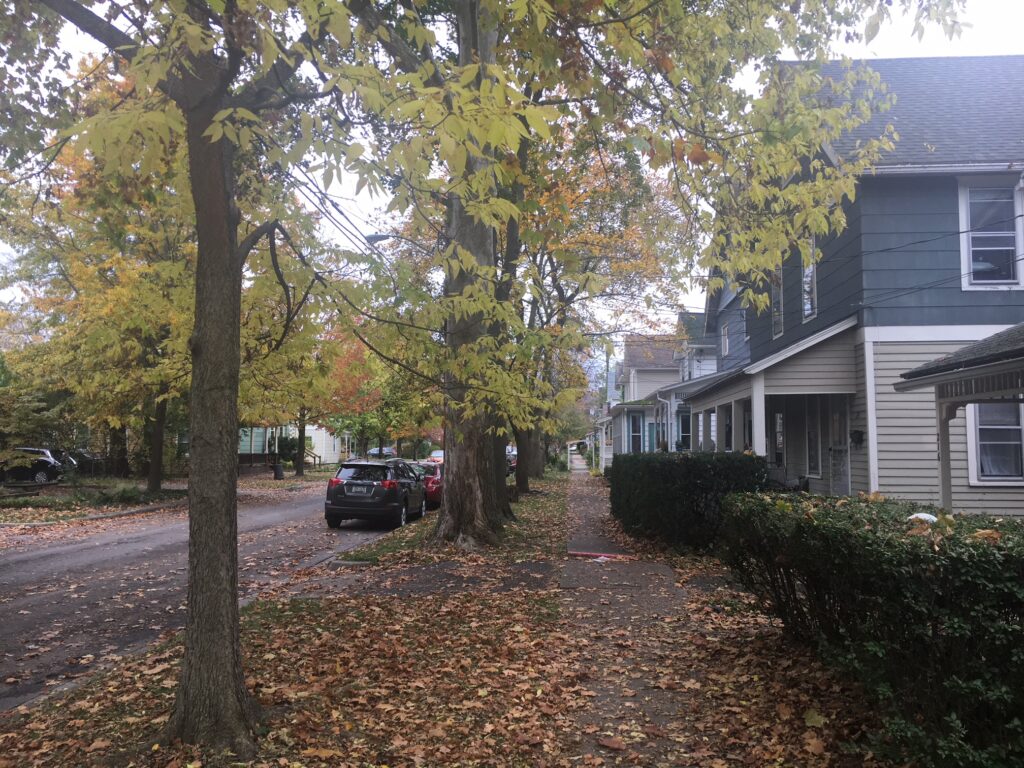This month we share dialogue we recently had with Ithaca based Rob Steuteville, editor of Public Square: A CNU Journal and senior communications adviser for the Congress for the New Urbanism. We have been following his articles on walkability and the 15 minute city and valued having a moment to hear more of his perspective.
“There are opportunities to redevelop malls, shopping centers, and office parks into mixed-use urban places. This is happening in quite a few places, and it is probably the best opportunity to transform these places. Also, you can start with the corridor and redesign the street, probably into something more like a boulevard. Extending transit into the suburbs and building transit-oriented development is another option.”
ROBERT STEUTEVILLE
Pedestrian Space: Your article Walkability indexes are flawed includes clear visual data depicting the problem of some areas being ranked high on walkability but in reality not being particularly pedestrian friendly. The Google street views really portray the problem well. Since writing the article, have you seen any changes to WalkScore or how data for these indexes is being produced?
Rob: No, I haven’t seen any changes or improvements.
Pedestrian Space: Having lived in a number of communities with streetscapes like the couple of Google Street view images you included in this article, I am all too familiar with the challenges of walkability in these areas. What do you view as some fundamental next steps for these areas, with, in reality, “Below Average Walkability” (as you note) to increase potential for pedestrian movement?
Rob: There are opportunities to redevelop malls, shopping centers, and office parks into mixed-use urban places. This is happening in quite a few places, and it is probably the best opportunity to transform these places. Also, you can start with the corridor and redesign the street, probably into something more like a boulevard. Extending transit into the suburbs and building transit-oriented development is another option.
Pedestrian Space: The article also included focus on walkability as a key factor for real estate investment. While this is a truly vital aspect of walkability research, I’m interested in your perspective on the critique and concern of walkability as a gentrifying force.
Rob: Walkability can raise values, but it also reduces cost of living by cutting household transportation expenses. I think that’s mostly a good tradeoff, especially in the suburbs. There’s so much mediocre development out in the suburbs that we could never gentrify it all, even if we tried. But we need to address the sustainability of these places.
On Walkability
“I think it’s an ideal, an aspect of good living, that cities and towns should strive for, much like employment, education, health care, sustainability, etc. It contributes to sustainability, health, fiscal health, and general quality of life.”
ROBERT STEUTEVILLE

Pedestrian Space: We view walkability as a fundamental right and a feature that should be viewed as a basic function of cities and towns. What is your perspective on viewing walkability as a civic right and basic community feature?
Rob: I’m not sure it is a civic right. Most of the country will never be “walkable,” because it is too far from anything. If someone chooses to live in the countryside or on a farm, it will not be walkable. I think it’s an ideal, an aspect of good living, that cities and towns should strive for, much like employment, education, health care, sustainability, etc. It contributes to sustainability, health, fiscal health, and general quality of life.
Pedestrian Space: I enjoyed your inclusion of Ithaca, your town, in the article as well. You reference South Albany Street, an area labeled ‘not very walkable’ by the National Walkability Index. However, you note that “This is a highly walkable street in a highly walkable city—Ithaca has the highest walk-to-work rate of any core city in the US at around 40 percent.” This is another great example of the problems in underestimating walkability. Having lived in Ithaca, I also appreciated this example as I experienced it as a truly walkable town. In terms of walkability, what aspects of Ithaca would you share as focal features?
Rob: It is a compact place. You get pretty much anywhere by walking and biking, notwithstanding the hills. Ithaca shows that you can do this without extremely high density (Ithaca is only about 5,000 people per square mile), and you can do this in a small city. A well-connected network of streets and a mix of uses throughout are important. And 15-minute cities can have a great connection to nature and surrounding countryside. Ithaca has that with the gorges, the waterfalls, the lake, and the nearby farms.
“A well-connected network of streets and a mix of uses throughout are important. And 15-minute cities can have a great connection to nature and surrounding countryside. Ithaca has that with the gorges, the waterfalls, the lake, and the nearby farms.”
ROBERT STEUTEVILLE
Pedestrian Space: What (if anything) do you think can be improved with pedestrian networks, access and walkability in Ithaca?
Rob: One big challenge is Route 13, an arterial thoroughfare that is a barrier between the city and its waterfront, and West End. There have been plans for almost a decade to turn this into a boulevard, and that would help. More widespread availability of electric bikes would also help with the hills.
“Many great thinkers in urban planning, from Christopher Alexander to Leon Krier to Peter Calthorpe, have made the quarter mile pedshed central to their thinking. Calthorpe also focused on the half-mile transit shed, a 10-minute walk. The 15-minute City, including both walking and biking sheds, takes these ideas to another level.”
Robert Steuteville
Pedestrian Space: In your article Defining the 15 Minute City you note that the 15 minute city may be garnering a great deal of media attention right now but that it has a long history including as a term that has been used in the transportation accessibility world for decades and in various new urbanist ideas such as the quarter-mile pedestrian shed. Can you share any more insight on this lesser referenced fact- that the concept has precedence in other forms?
Rob: Many great thinkers in urban planning, from Christopher Alexander to Leon Krier to Peter Calthorpe, have made the quarter mile pedshed central to their thinking. Calthorpe also focused on the half-mile transit shed, a 10-minute walk. The 15-minute City, including both walking and biking sheds, takes these ideas to another level.

Pedestrian Space: Part of our core focus is exploring the reality of existing 15 minute cities. There are cities and towns across the planet that already exist as such and we view it as useful to exploring planning history and principles in these areas to gain insight into their development. What are your thoughts on this and do you have any towns or cities to recommend to us to add to our research list?
Rob: I think any city built prior to 1950 has the bones of a 15-minute city. It’s a question of what is missing? What needs to be repaired and added to make it work as a 15-minute city?
Pedestrian Space: Do you think Ithaca fits the model of a 15 or 20 minute city (or has the potential to)?
Rob: Yeah, I think Ithaca works really well. There are some problems that need to be solved but we are most of the way there.
Pedestrian Space: You note that “Urbanists can salvage the 15-minute city from its destiny as a cliché if it is defined clearly, with flexibility, but without too much slack. So defined, it becomes a tool that activates the array of principles that promote livable, healthy, sustainable societies.”
We also view this as critical- the potential for this concept to contribute to the development of truly livable, healthy and sustainable societies.
Rob: The concept has a lot of potential and could use some additional refinement. Andres and I are working on some follow-up articles that we hope will contribute to that discussion.
Thank you for your time Rob and we look forward to reading more of your articles and perspectives on these issues.

Robert Steuteville is editor of Public Square: A CNU Journal and senior communications adviser for the Congress for the New Urbanism.
Visit Congress for the New Urbanism on Twitter & Public Square: A CNU Journal’s at https://www.cnu.org/publicsquare/welcome-public-square-cnu-journal

